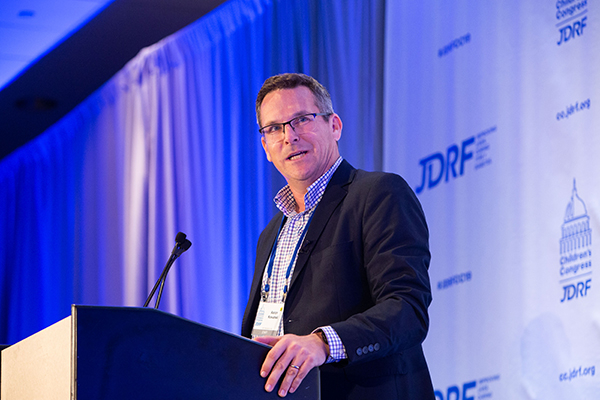Rutgers Alumnus Leads Charge to Find Cure for Diabetes
Aaron Kowalski is the first person living with type 1 diabetes to lead the world’s largest nonprofit funder of diabetes research

At 13 years old, Aaron Kowalski already knew the signs of diabetes since his younger brother Stephen had been diagnosed with the disease at the age of 3: loss of weight, frequent urination, unquenchable thirst and fatigue.
Kowalski noticed he was waking up repeatedly during the night to use the bathroom, and during the day, he kept excusing himself from class to drink from the water fountain. At home, he was constantly drinking orange juice, which only exacerbated the problem by causing his blood sugar levels to spike.
“It became a vicious cycle, and I really just reached my wits end and then kind of realized that this didn’t add up,” Kowalski recalled. “And I said, ‘I think I have diabetes.’”
In April, Kowalski became the first person living with type 1 diabetes to be appointed president and chief executive officer of the JDRF (formerly Juvenile Diabetes Research Foundation), the leading global organization funding type 1 diabetes research. Kowalski, who holds an undergraduate degree and doctoral degree from Rutgers, has devoted his career to finding a cure for diabetes. He has worked for the nonprofit organization, based in New York City, since 2004.
“There is no one more qualified than Aaron to lead the JDRF’s fight to end this disease,” said Derek Rapp, who preceded Kowalski as CEO. “He embraces the important role of volunteers and donors on the path toward a cure, living our cause every day and demonstrating there are no limits to what people with the disease can achieve.”
Kowalski started his career at the JDRF as a scientific program manager and immediately began focusing on the development of a device that would transform the treatment of diabetic patients — the artificial pancreas, a pump that releases insulin into the body automatically based upon glucose levels.
In addition to establishing the artificial pancreas project at the JDRF, which funded the research to develop it, Kowalski published a paper in 2009 that laid out a road map for how the insulin pump could be designed, which helped significantly drive progress on these devices. “That really focused the field on driving the science forward and ultimately delivering commercial solutions,” Kowalski said, adding that a first-generation artificial pancreas was first approved in 2016.
“Having struggled through this with my brother, the unmet need was clear, and I wanted to make a difference.''
For many years, Kowalski and his brother gave themselves four to six insulin injections a day, in addition to pricking their fingers multiple times a day to measure their blood sugar. But daily injections and blood tests have been reduced and even eliminated by the development of the insulin pump combined with a continuous glucose monitor that checks blood sugar levels through a patch on the skin.
Living with diabetes inspired Kowalski to study engineering at Rutgers with the hope of seeking dramatically better treatment options for the disease through engineering. He then switched to biology and earned bachelor’s degree from Rutgers College in 1994 and a Ph.D. in microbiology and molecular genetics in a joint degree from Rutgers Graduate School and Robert Wood Johnson Medical School in 2005.
“Having struggled through this with my brother, the unmet need was clear, and I wanted to make a difference,” he said. In both his undergraduate and graduate studies at Rutgers, Kowalski said he wanted to gain the foundational skills in science to pursue a career in research.
Kowalski credits his doctoral adviser, David Denhardt, emeritus professor of cell biology at Rutgers, with teaching him the tools that enabled him to fulfill his dream of finding a cure for diabetes. “He was an amazing renowned scientist and really helped me build the skills that I use today to think critically about science and about new ways to solve problems,” he said.
The JDRF provides about $100 million in research funding a year aimed at finding cures for type 1 diabetes and better treatment options to improve diabetes health and reduce the burden of management of the disease.
The autoimmune disease, which strikes both children and adults, is caused when the immune system attacks and kills cells in the pancreas that make insulin, a hormone the body needs to move sugar from the bloodstream to the cells where it is used for energy. The JDRF also focuses extensively on policies, both in the United States and globally, that support federal funding of diabetes research and policies that ensure affordable access to new diabetes devices and drugs.
People with type 2 diabetes, which is far more common, are able to make insulin but the hormone doesn’t work properly or isn’t made in sufficient quantities for the body’s needs.
While the artificial pancreas has helped people manage diabetes, Kowalski said the device is a mechanical solution, and not a cure. “I often joke that nobody signs up to wear an insulin pump who doesn’t have diabetes," he said. “You’re doing that because it delivers better outcomes, but it’s not something you would choose to do for fun.”
The new frontier of diabetic research focuses on restoring insulin production, either through stem cell-based transplants and through regeneration of the insulin-producing cells in the pancreas, or through immunotherapy that could restore immune balance and possibly prevent type 1 diabetes.
“As CEO, my role is to try to help us develop cures for type 1 diabetes as fast as humanely possible,” he said. “So it’s really about an acceleration of research, driving more resources to type 1 diabetes and ensuring that people are healthy when we get there.”